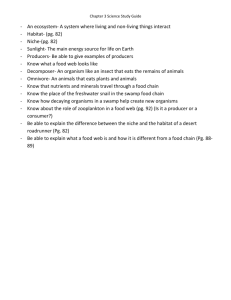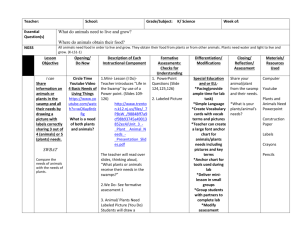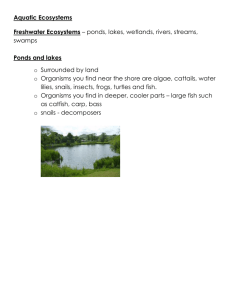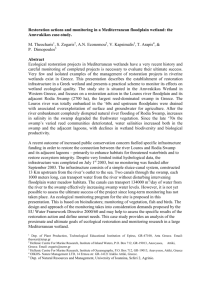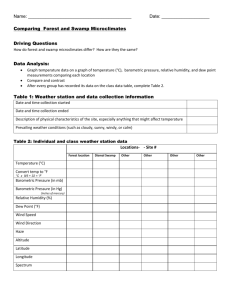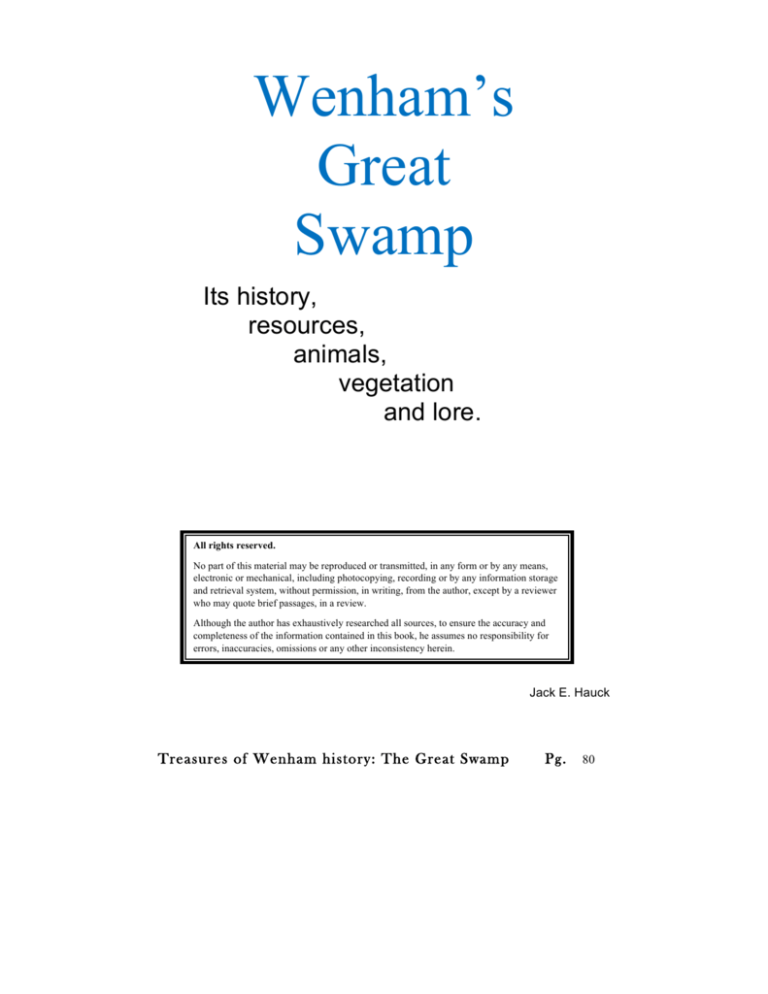
Wenham’s
Great
Swamp
Its history,
resources,
animals,
vegetation
and lore.
All rights reserved.
No part of this material may be reproduced or transmitted, in any form or by any means,
electronic or mechanical, including photocopying, recording or by any information storage
and retrieval system, without permission, in writing, from the author, except by a reviewer
who may quote brief passages, in a review.
Although the author has exhaustively researched all sources, to ensure the accuracy and
completeness of the information contained in this book, he assumes no responsibility for
errors, inaccuracies, omissions or any other inconsistency herein.
Jack E. Hauck
Treasures of Wenham history: The Great Swamp
Pg.
80
Wenham’s Great Swamp
Wenham’s Great Swamp is not only in Wenham. Portions also are in
Hamilton, Topsfield and Ipswich. In total, the swamp covers about two
thousand acres, and is the largest fresh-water marsh on the north shore.
The last glacier formed the swamp, when it receded from the North
American continent, about 10,000 years ago. As it receded, it deposited
soil and rocks – called till - in the massive kettle hole that the glacier had
cut though the bedrock.
Some deposits formed elevated areas, which became islands of various sizes and shapes.
Several drumlins make up the swamp's most conspicuous high
ground. They are long, rounded hills molded by glaciers as they moved.
They point in a parallel to the glacier’s path. Pine Island is a drumlin.
Other features include:
Kettle-hole ponds, such as Cedar Pond in Wenham, were shaped by
big chunks of ice, broken off the glacier and buried in the soil. When the
ice melted, a pond basin was formed.
Treasures of Wenham history: The Great Swamp
Pg.
81
Eskers, such as Fowler’s Island, are the sediment left behind as a glacier melts, often in
the shape of a low winding
ridge.
Kames, such as Fox Island, are similar to Eskers,
since they also originated
from the sediment dropped
by melting glaciers into depressions, which slowly grew
into small hills.
The material of these elevated areas is "till," which
consists of an assortment of
Drumlins make up the swamp's most conspicboulders, pebbles and fine
uous high ground. Photo, Bing Maps
sand and clay.
Over the centuries that followed, vegetation grew on the islands, and in
shallow areas. These plants and trees died and accumulated to form
marsh areas.
With the run-off of the melting ice, brooks and streams formed in the
swamp. The result is a huge natural aqua filter.
Wetland vegetation provides a natural filter, to which micro-organisms
grow and which break down organic materials. These microorganisms are
called the periphyton, which is responsible for about 90% of pollutant removal and waste breakdown.
Water
Water in the nearby Great Pond, what we now call Wenham Lake, came
from several underground springs, and, indirectly, drain off from the great
swamp.
The water from the swamp was naturally purified, before it reached the
great pond. Thus, the Great Pond became known around the world for its
unmatched purity and clarity.
In the 1800s, man interfered with nature, and the Great Pond began to
be filled with less pure water.
Around 1880, a canal – more accurately, a ditch – was dug to drain
Cedar Pond, which adjoins the swamp, and the surrounding area, into
Wenham Lake.
Treasures of Wenham history: The Great Swamp
Pg.
82
Next, from 1914 to 1918,
the Beverly and Danvers Water Board dug a canal straight
across the Wenham Swamp,
from the Ipswich River. The
canal delivers water to the
northern end of the lake, at
Cedar Street.
Water quality deteriorated
with the addition of this extra
supply, and it was necessary,
in 1935, to build a large water
purification plant, in North
Cedar Pond, a kettle hole, was formed when
Beverly.
glacier melted. Photo, Bing Maps
Wenham does not draw
water from Wenham Lake. Wenham’s water comes from two gravelpacked wells (approximately 50-feet deep), located at the south end of
Pleasant Pond, off Pleasant Street.
The wells draw water from the aquifer below the Great Pond. The periphyton provides a natural filter; thus we do not need a filtration plant.
Lately water problems have developed. Measures taken to keep the
water safe have recently affected the taste and smell. The Massachusetts
Department of Environmental Protection says Wenham has the last distribution system, of its size in Massachusetts that does not add chlorine.
In the future, chlorine will be added.
Fuel and Lumber
For the early settlers, the Great Swamp was a valuable source of fuel –
called peat – used for cooking and heating.
Most peat bogs grow slowly, at the rate of about a millimeter per year.
At one time, the peat beds in the great swamp were as much as fifteen
feet deep. That works out to they were, at the bottom level, nearly 5,000
years old. More commonly the beds are from five to eleven feet thick.
Back when peat was being harvested, it was generally done between
the middle of August and the middle of September, just after the swamp’s
dry period. The water level receded allowing easier access to the peat
beds.
Treasures of Wenham history: The Great Swamp
Pg.
83
Fowler’s Island, an esker, was formed by sediment left behind as a glacier melted. Photo, Bing
After being dug from the
bog, the water-logged peat
blocks were placed on dry
areas alongside the bog.
When thoroughly dried and
much lighter, the blocks were
carried to a “turf house,” for
storage. Many turf houses
(wooden barns), in the
1800s, were built alongside
Valley Road, in Tops-field,
and the Wenham causeway.
Peat was a substitute for
wood, and not for coal. Anthracite coal was not introduced into New England until 1828. Peat was dirty to handle and burned
with a peculiar odor and a brisk fire could not be made from it.
Maps
Peat was not the only valuable resource. When settlers first ventured
into the Great Swamp, they found that its many islands had very broad
and tall trees, suitable for building houses. Also, many smaller trees,
which could be burned for heat, grew in the marsh areas. These resources were important. Since most of the trees on dry lands had been
harvested or were on private land.
George Washington, visiting Essex County in 1789, wrote in his diary,
“The Country (between Boston and Salem) seems to be in a manner entirely stripped of wood.”
Initially, the Great Swamp was considered to be common land, which
all people could access for farming, grazing for their live stock and collecting timber and fire wood. However, as the 18th century began, the town
government decided that the Great Swamp should be divided among designated groups of the town’s people. There had been many arguments
about who could take wood from the Great Swamp.
The selectmen divided the swamp into nine sections, each fifty feet
wide and 200 feet long. Groups, called companies, with eight land owners
in each, were formed. This was done Nov. 18, 1705.
Wood removal began by cutting from the front and working back. It
was thought that by time the back was reached, new trees would have
grown at the front and the cutting would begin again from the front. This
was a very optimistic program, since large trees were cut down faster
than planted trees grew to equal sizes.
Treasures of Wenham history: The Great Swamp
Pg.
84
Wenham selectmen, in 1705, divided swamp into nine sections and groups of
landowners were given sections as private land. Map, Wenham Town Records.
Islands
There are fifty islands in the Great Swamp; however only about a dozen
are of any appreciable size. Islands within Wenham include:
Pine and Hemlock Knoll has large stands of hemlock, white pine, and
black birch. A half-mile trail loops around the perimeter of the knoll, now
owned by the Hamilton Wenham Open Land Trust.
Wolf Island is not as big as it originally was. When the Ipswich-Salem
Canal was dug, it cut the island in two.
The name came from early settlers seeing some wolves on it. The
wolves did not last long for, in 1644, there was a bounty of twenty shillings on them.
Woodside Lane, which leads to Wolf Island, originally was known as
The Way to Wolf Island. At Wolf Island, the path intersected with the main
road, called The Highway, which went to Fowler’s Island.
Treasures of Wenham history: The Great Swamp
Pg.
85
Islands in other towns are: Turkey, Horse, Colt, Candlewood, Pine, Fox, Grape
and Averill. USGS Topo Map
There are fifty islands in the Great Swamp; however only about a dozen are of
any appreciable size. USGS Topo Map
Huckleberry Island, also called Perkins Island, in 1703 was involved in the
purchase of a new meeting house bell in Wenham. It was “Voted Ensign Fairfield, Lt. Thomas Fiske, or Ens. John Porter are appointed a committee to sell our
old bell and to agree with Zacheus Perkins for the sale of our commons on Huckleberry Island and to fetch our new bell home & see to the hanging of it.”
Snake Island, which is in Wenham, got its name from the large number
of snakes found on it. The island, off the southwest tip of Fowler Island,
only can be reached by boat.
Fowler Island, which is mostly in Wenham and partly in Hamilton, is
the largest island in the Great Swamp. Originally, Joseph Fowler, of
Wenham, owned it. The highest spot is 66 ft.
Perkins Island, aka Huckleberry Island, which is in Topsfield and Wenham, originally, 1639, was owned by John Perkins. It only can be reached
by boat.
There are two granite town boundary markers on the island.
Treasures of Wenham history: The Great Swamp
Pg.
86
There are several old paths in the Great Swamp, but most have become overgrown and have flooded sections. USGS Topo Map
Islands in other towns include:
Turkey Island, which is in Hamilton, got its name from the large number of wild turkeys on it. The highest spot is 75 ft.
Horse Island, which is in Hamilton, is not named for it horse head
shape. The origin of the island's name is not known. At one time, it could
be reached by a trail that ran beside the Idlewild Brook, but this is no
longer possible. The highest spot on the island is 35 ft.
Colt Island, close to Horse Island, is privately owned, however, the
owner permits the use of the facility for day trips and overnight camping.
The island, which is in Hamilton, has well-maintained and defined
walking paths. No reference was found with regard to the origin of the
name.
Candlewood Island, which is in Hamilton, draws its name from the resinous Candlewood Trees that are on it and that were used for torches and
candle substitutes.
Treasures of Wenham history: The Great Swamp
Pg.
87
Rail Trail entrance off of Rte. 97, heading toward Topsfield, is open to hikers
and bicyclists. Photo, J. Hauck.
The island affords a spectacular view of the swamp. The highest spot
is 79 ft.
One of the larger islands in the swamp, covering two acres, Candlewood Island is owned by the Hamilton Wenham Open Land Trust. During
the dry season, the island is accessible by foot, from Colt Island.
Pine Island is in Topsfield. Its high spot is 56 ft. It only can be reached
by boat.
Grape Island, which is in Ipswich, is quite small and low and only can
be reached by boat.
Fox Island, a very small kame between Averill’s Island and Pine Island,
is in Topsfield. Information could not be found concerning the source of its
name. It only can be reached by boat.
Averill’s Island, which is in Topsfield, can be reached by an unpaved
road connecting the island with the mainland, from Bradstreet Hill to the
Steward School on Perkins Road. The highest spot on the island is 46 ft.
Treasures of Wenham history: The Great Swamp
Pg.
88
The Ipswich River passes through the Great Swamp before proceeding to the
Atlantic Ocean. Map, North Reading.gov.
The Ipswich Wildlife Sanctuary owns most of the Great Wenham
Swamp. In addition, the Trustees of the Reservations owns Pine and
Hemlock Knoll; and the Hamilton-Wenham Open Land Trust owns Candlewood Island.
Trails
There are several old paths in the Great Swamp, but most have become
overgrown and have flooded sections.
The Great Path, across Pine & Hemlock Knoll and out to Wolf Island,
is no longer useable.
Salem-Beverly Waterway, dredged and widened in 1974, has gravel
roads on each side, which provide good paths through the swamp. Make
sure you walk along the left side, for the bank on the other side has several breaks in it.
The paths can be reached at the end of Old Town Way, which is off of
Cherry Street. It is about a mile to the end of the path, on the left side of
the canal.
The Highway is still carried as a Wenham town road, but it is overgrown and overflowed in several stretches.
The Way to Horse Island no longer is intact all the way to Horse Island.
Treasures of Wenham history: The Great Swamp
Pg.
89
The small
brooks are fascinating, both
to see and hear.
Sunlight flashes
off the rivulets
and there is a
melodic babbling.
Photo, J. Hauck
Pine & Hemlock Knoll has a short trail around its circumference, as
well as paths crossing the island.
There is a driveway, 93R, off of Pleasant Street that leads to the knoll.
The trail begins at back of the Blanchette property. Best thing is to call
ahead and ask them to allow you to park on their property, and walk the
trail to Pine & Hemlock Knoll.
The Rail Trail is a new path through the swamp.
There once was a rail line, the Newburyport Railroad, running through
the swamp, on its Topsfield side. It ran from Newburyport to Georgetown,
in 1849 and 1850, and west to the B&M, at Bradford, in 1851. Through a
couple of mergers, the line eventually ran to Wakefield.
Starting in 1941, sections of the line were abandoned. The first to go
was the line from Newburyport to Topsfield, which ran through the Wenham Swamp.
In 2009, plans were initiated to create a bike and pedestrian path for
about a mile of the abandoned Newburyport RR through the Wenham
Swamp. The Rail Trail, completed in 2011, stretches from Danvers to
Salisbury.
The old tracks and ties were removed by the Iron Horse Preservation
Society, at no cost to the towns. Mass Highway constructed the bicycle/pedestrian crushed stone path.
Treasures of Wenham history: The Great Swamp
Pg.
90
Under the terms of the lease agreement, Wenham agreed to lease its
portion of the Rail Trail for 99 years, and to be responsible for maintaining
the trail.
In Wenham, there are two sections of the Rail Trail. One goes north to
Topsfield, off of Rte. 97. The other goes south, off of Rte. 97, to Danvers.
Streams
As many avid canoeists will attest, there are several intriguing streams
running through the Great Swamp.
Two of the larger ones are:
The Ipswich River, 45-miles long, begins at the junction of Lubber and
Maple Meadow brooks in Wilmington. It passes through the towns of
Reading, North Reading, Middleton, Topsfield, Hamilton, and flows into
the Atlantic Ocean at Ipswich.
Idlewild Brook exits Pleasant Pond, at its north end. It snakes its way
through the swamp and, eventually, intersects with the Ipswich River,
near Candlewood Island. The water does not run rapidly, so paddling
back will not be too tiring.
Animals
In effect, the Great Swamp is a natural zoo. There are a great many different creatures living in, on and over the Great Swamp. However, you
will have to be very alert to see or hear them.
Many of the creatures and plants in the Great Swamp are considered
rare or endangered, in Massachusetts.
The Eastern coyote, at first glance may look like a mangy dog.
Coyote dens are located on slopes, banks, or rocky ledges, and are often hidden under downed trees, stumps, or in culverts.
They can be active night or day, and sightings at dawn or dusk are
common. At such times, they communicate with their characteristic howling.
Fishers, incorrectly called “fisher cats,” belong to the weasel family,
which includes mink and otters. Adult male fishers weigh 8 to 16 pounds
and measure approximately 3 feet from head to tail.
They tend to be active at night and during the hours at dusk and dawn.
The cry of a fisher cat sounds a bit like a person screaming when the
victim of a violent attack. Once you’ve heard one, you will not forget the
sound.
River otters are long, streamlined animals with short legs, webbed feet,
and a wide, rounded head with small ears.
Treasures of Wenham history: The Great Swamp
Pg.
91
A typical adult weighs 11 to 23 pounds, and is 3 to 4 feet in length.
To communicate, river otters whistle, growl, chuckle, and screech.
Mink are relatively small animals, generally only about a foot in length.
They are nocturnal creatures.
Turtles, of the smaller species, are often seen basking on a log.
Eastern box turtles, an endangered species, are slow crawlers, extremely long lived, slow to mature, and have relatively few offspring per
year.
And, yes, turtles make sounds … something like coughing.
Here, quickly, are some other animals you may see in the Great
Swamp:
The red fox is usually recognized by its reddish coat and black "legstockings." The red fox is 22 to 32 inches in head and body length, and
the tail is 14 to 16 inches long.
The gray fox has rusty-red fur, on its ears, ruffs and neck. Overall coloration is gray, and the darkest color extends in a suggested stripe along
the top of the back down to the end of the tail. Compared to red fox, grays
have shorter muzzles and shorter ears, which are usually held, erect and
pointed forward. Many grays are about 15 inches tall at the shoulders and
overall lengths are around 40-44 inches, including a tail of 12 to 15 inches. The gray fox is the only fox that climbs trees.
Woodchuck, the name comes from the Algonquin word, ockqutchaun;
they also are called groundhogs. They are excellent burrowers and hibernate during the winter. Adults are 20-28 inches in total length, with the tail
about 4-7 inches. They can swim and climb trees. Woodchucks communicate making "chuck-chuck" noises. However, when alarmed, they
use a high-pitched whistle to warn the rest of their colony.
Algonquin is a name French settlers gave to the Indians. The French
were trying to pronounce the native word, ”Algoomaking.” The Algonquin
call themselves Anishnabek, which means original people."
Opossum, the name comes from the Algonquin word, wabissim. They
basically are nocturnal. Their tail is prehensile and is able to hold or seize
objects. When confronted, an opossum will show its teeth, hiss and growl.
Skunk, the name comes from the Algonquin word, seganku. On very
warm nights, skunks will be out searching for food. When temperatures
are below freezing, they sleep to conserve energy. When threatened, a
skunk will turn its hind-end towards the threat and eject a stream or fine
mist at the threat. Skunks have many predators, including Great-horned
owls, coyotes, foxes and domestic dogs.
Treasures of Wenham history: The Great Swamp
Pg.
92
Pine & Hemlock Knoll has a well defined trail. Photo, J. Hauck
Raccoon, the name comes from the Algonquin word, arakun. The raccoon is identified by its black face mask, outlined in white, and its bushy
tail with alternating black and gray rings. Raccoons are mostly active at
dawn and dusk and at night. They make a wide range of sounds, often
sounding like birds.
White-tail deer have long, slender legs; large ears; and a tail that,
when the deer is alarmed, flares erect to reveal the white underside.
White-tailed deer are most active at dawn and dusk. Deer make many
different sounds, including grunts, burping, and one that sounds like the
blowing of one’s nose.
Cats, abandoned domestic animals, are in the Great Swamp. Many
have short lives, for they are killed by predators.
New England cottontail rabbits are becoming very rare. They are active at dawn, dusk and during the night. The New England cottontail rabbit
is a semi-aquatic animal. Its watery habitats offer food and protection
from predators.
Snakes of several different types, as would be expected, are in the
swamp. There include: Garter snakes, black snakes, brown snakes,
green snakes, and water snakes.
Frogs, of many different types are in great abundance in the Great
Swamp.
Treasures of Wenham history: The Great Swamp
Pg.
93
Rupert Lillie’s 1976 map of where Wenham houses were in 1776 depicts half a
dozen houses in The Great Swamp.
Salamanders of many types can be seen, including the blue-spotted
salamander, which is an endangered species.
If you are a bird watcher, then the Great Swamp is a special place for
you. There is not enough time to mention all the different species, but a
few are worthy of note.
The Great White Egret has a very unusually sound, almost like deep
gurgling. Take the time to watching them stealthily and slowly pursue their
prey.
The Bald Eagle is unmistakable. Once very large in number, there now
are very few … DDT was their undoing.
Wild turkey … the official state game bird of Massachusetts … Benjamin Franklin wanted it to be the national bird, rather than the eagle. No, it
does not make the gobble-gobble sound … it clucks.
Several types of hawk inhabit the Great Swamp. Look for the male
Cooper’s Hawk. Females are up to one third larger than males. The
Cooper’s Hawk is listed as an endangered species.
Treasures of Wenham history: The Great Swamp
Pg.
94
Trees and Vegetation
Trees dominate the swamp, especially in the summer and fall.
Ash, both white and green, are generally found in groups.
Birch, mostly white, yellow and gray. Birch sap is distilled to make
birch oil which with carbonated soda makes birch beer.
Cedar once were in great number, but this is no longer the case.
Hemlock are everywhere. Hemlock sap was used to kill Socrates.
Maples are the most dominant tree. These are mainly swamp maple,
but there also are red maples, Norway maples and silver maples.
Red maple is the most familiar swamp tree. Its brilliant fall foliage lights
up the watershed’s extensive swamps in September and early October.
Oak, both white and red, are few in number. Once there were many.
Spruce also are everywhere.
Pine, both white and red. In colonial times, the tall white pine were
called mast pines. Some masts were as high as 120 ft., and 4 ft. in diameter, at the base.
There are far too many different types of vegetation for me to go into in
this presentation, but there was one species that I should mention. It’s
called “weed.”
Back in 1966, a local newspaper article described how $1 million worth
of marijuana plants – aka weed - were discovered growing in the Great
Wenham Swamp. People wondered how the cash crop could have escaped detection for so long. The Tree Warden, Al Dodge, denied having
any involvement in growing the plants.
Some of the low and non-woody plants which you’ll see in wetlands
throughout this region are skunk cabbage, a harbinger of spring; many
other ferns; as well as wildflowers too numerous to list. Look for skunk
cabbages beginning to emerge even in the snow of late winter – they can
do this because they produce their own heat, keeping the core of the
plant about 36 degrees F warmer than the outside air temperature!
Two plants which you really should learn, if you are going to explore
the swamp, are poison ivy and poison sumac.
Poison ivy’s distinctive 3-part leaf varies considerably in shape, color,
glossiness and edging.
Poison sumac is even more toxic, though less common.
Jewelweed is another plant you may wish to know about. The juice of
this plant is said to be an antidote to the toxins in the poison ivy and poison sumac.
Treasures of Wenham history: The Great Swamp
Pg.
95
The Adder’s Tongue, though not a snake, is another plant to keep a
keen eye out for. Though it doesn’t look like one, it’s a fern. An old ointment for wounds, called "Green Oil of Charity," is made from it.
Former Inhabitants
Former inhabitants, yes, at one time, there actually were people living in
the swamp, included:
Asa Kimball, a resident of Boxford, he was a blacksmith;
John Friend, who was very active in Wenham’s government and a
deacon in the church;
Daniel & Benjamin Fiske In 1736, Daniel Fiske sold land to the town to
build a school-house for the children in the western part of Wenham.
Capt Samuel Russell Trevett, a resident of Marblehead, had a house
on Fowler’s Island. He served at the battle of Bunker Hill.
William Fiske was a member of the Salem witch trial that convicted
and hung Sarah Good, Jul. 19, 1692.
John Perkins, Jr., as a young man, lived in a hut on his father's island,
Perkins Island. While there, he is said to have prevented an Indian plot to
attack Salem and Ipswich.
Great for Hiking
There is so much more to see in the Great Swamp.
Butterflies and other insects. Fish. Amphibians. Town boundary markers.
There also are tales of ghosts living in the Great Swamp. Perhaps
people that became lost and were never found. Indian medicine men are
said to have gone into the swamp to gather magic elixirs.
In December 1964, a husband and his wife, who lived on Pleasant
Street, became lost in the Great Swamp. That evening, the couple were
found, however, the pregnant woman, unable to walk back, was evacuated to a hospitable by a helicopter. 13, 14
Well, are you now excited about taking a walk through the Great
Swamp?
The best time would be in late fall, after a heavy frost.
The bugs are gone, especially the mosquitoes.
Before starting on a hike, you’d be advised to bring the following
things:
High-top walking boots – Some places, along the way, will be soggy.
Gloves – There are some large branches that will need to be moved
off the path.
Treasures of Wenham history: The Great Swamp
Pg.
96
Ipswich River Wildlife Sanctuary provides guided tours of the swamp.
Hat with a bill – The sun’s glare can get quite strong, on bright days.
Actually, the best kind of hat is the acacia hat.
Water – If you get thirsty, and you probably will, there are no water
fountains in the swamp.
Binoculars – There will be things out in the wet areas that you’ll want to
more closely look at.
Phone – If help is needed, you’ll want to be able to call someone.
First aid kit – Nothing is likely to happen, but safety is always the best
precaution.
Bug spray – Just in case a few are still around.
Knapsack – You’ll need something in which to carry all your stuff.
There is one basic rule: leave the swamp the way that you found it.
Don’t leave garbage.
Don’t take anything, other than photos.
Don’t mark anything.
OK, you’re ready to go.
Treasures of Wenham history: The Great Swamp
Pg.
97
One last suggestion.
Some trails are easy to find, some have markers, but for most you’ll
likely need a good guide, for there are no maps.
There once were trail markers, but these are gone for the most part.
You can go to the Mass Audubon’s Ipswich River Wildlife Sanctuary,
87 Perkins Row, Topsfield, for guided tours of the swamp. There are 10
miles of trails.
Updated 06-01-2014
REFERENCES
01 - “Wenham in Pictures & Prose, 1643-1993,”
Published by the Wenham Historical Association & Museum, Inc., 1992
02 - “When They Burned Peat in Middleton,”
spnea.org/resources/articles/pdf94
03 - “History of Salem Massachusetts, The,” Sidney Perley, 1924-1928
04 - “Swamp Thing,” The, Boston Globe, 09-151996
05 - “History of Wenham, The,” Dr. Myron O.
Allen, 1860
06 - “Voice of the River, The” Ipswich Watershed
Association, Spring 2002
07 - “Notes on Wenham History, 16431943,” by Adeline P. Cole, 1943
08 - www.mass.gov/dfwele/dfw/wildlife/
living/living_with_coyotes.htm
09 - Lord’s Hill Houses & Lands
Associated with Lord’s Hill
Wenham, 1637-1983, Wenham,
Massachusetts, By Rupert B. Lillie,
1984
10 - archive.org/stream/descen
dantsofwillams/descendants
ofwillams_djvu.txt
11 - www.massaudubon.org/
NatureConnection/Sanct
uaries/Ipswich_River/index.
php
12 - http://www.massaudubon.org/
Nature_Connection/wildlife/
index.php?subject=Mammals
&id=70
13- Lost Couple Found In Wenham Swamp, Salem
Evening News, Dec. 7, 1964.
14 – Find Lost Hikers In Wenham Swamp, Hamilton-Wenham Chronicle, Dec. 9, 1964.
Treasures of Wenham history: The Great Swamp
Pg.
98
Addendum A:
Lots Drawn in Wenham Swamp Common 3
First lot
Barr, John
Batchelder, David
Dodge, Josiah
Fairfield, Walter
Fisk, Sr. Thomas
Hutton, Richard
Symonds, Robert
Symonds, Jr., Robert
Second lot
Berry, John
Edwards, Benjamin
Edwards, Thomas
Gott, John
Herrick, John
Herrick, Joseph
Knowlton, Richard
Larcom, Mordecai
Third lot: W3 & E8
Coy, John
Edwards, John
Fisk, William
Fowler, Joseph
Friend, James
Kimball, Sr., Samuel
Kimball, Thomas
Stewart, John
Fourth lot:
Dodge, Mary
Dodge, Ruth, for her husband's
estate.
Fisk, Benjamin
Fisk, Jr., Samuel
Fisk, Sr., Samuel,
Haggett, Henry
Knowlton, William
Moulton, Jonathan
Fifth lot
Dodge, William, one share
Fairfield, Walter, two shares
Fisk, Thomas, two shares
Goldsmith, Zaccheus, one share.
Waldron, Nathaniel, two shares
Sixth lot
Dodge, Richard
Gott, Jr. Charles
Kilham, Daniel
Patch, Sr. Thomas
Patch, Stephen
Perkins, John
Rogers, William
Trowt, Tobias
Seventh lot: W7
Batchelder, Ebenezer
Batchelder, John
Dennis, John
Fisk, William Jr.
Hooker, Joseph
Hull, ??
Kimball, Samuel Jr.
Leech, John
Eighth lot: W8
Batchelder, Joseph
Kilham, John
Kimball, Caleb
Kimball, Ephraim
Maxey, David
Patch, Timothy
Rix, Theophilus
Wallis, Joshua
Ninth lot
Cue, widow, one share.
Fisk, Theophilus, one share.
Gerrish, one share.
Porter, Lt. John, three shares.
White, Thomas, one share.
Treasures of Wenham history: The Great Swamp
Pg.
99
Addendum B:
Endangered Species5
Vegetation
Adder's-tongue fern
Atlantic white cedar
Broom crowberry
Dwarf mistletoe
Hall's bulrush
Lion's foot
New England blazing star
Pale green orchis
Pod-grass
Red pine
Reed bentgrass
River birch
River bulrush
Seabeach needlegrass
Slender cottongrass
Small burreed
Small yellow showy lady's
slipper
Tiny cow-lily
Variable sedge
Fish
Bridle shiner
Amphipod
Mystic Valley amphipod
Eastern pond mussel
Butterflies
Kennedy's emerald
Hessel's hairstreak
(67 butterfly species have
been recorded)
Reptiles
Blanding’s turtle
Eastern box turtle
Spotted turtle
Amphibians
Blue-spotted salamander
Four-toed salamander
Marbled salamander
Spotted salamander
Birds
Cooper's hawk
Coppery emerald
Golden-winged warbler
Pied-billed grebe
Least tern
Least bittern
Northern harrier
Piping plover
Other Insects
Coppery emerald
Treasures of Wenham history: The Great Swamp
Pg.
100

